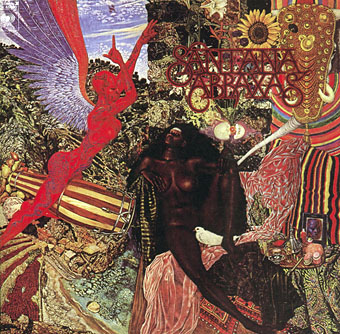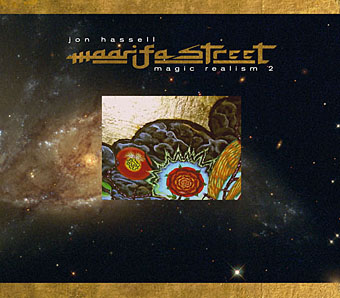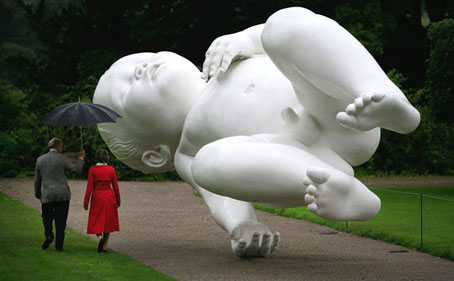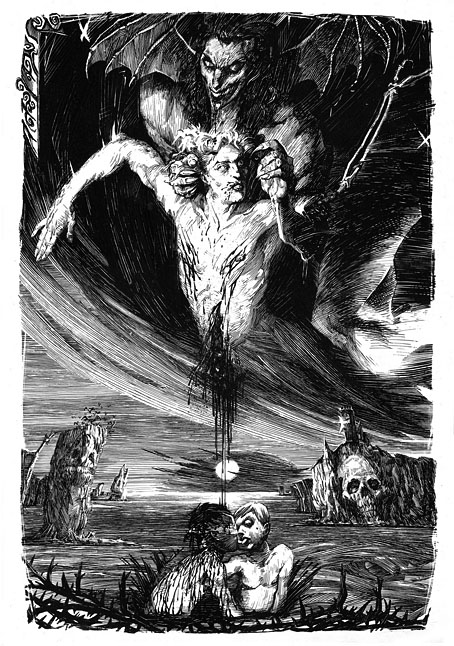Surreal case of the Dalí images and a battle over artistic licence
Tag: Salvador Dalí
The art of Mati Klarwein, 1932–2002
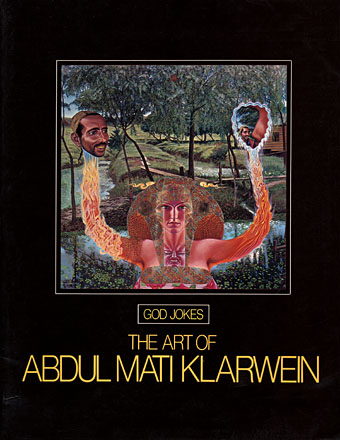
If book collecting is frequently a waiting game, some waiting periods can be longer than others. In the case of Mati Klarwein’s God Jokes, my patience and hope have sustained themselves for 28 years until I finally acquired a copy this Thursday afternoon. God Jokes was the second book of Mati Klarwein’s work, published by Harmony Books, New York, in 1976, a slim catalogue-style collection of his paintings, some of which were featured in the early issues of Omni magazine. In 1979 and 1980 God Jokes turned up in a chain of UK remainder shops and for a while it seemed like everyone I knew owned a copy which possibly explains my unaccountable decision to avoid buying one myself. As the years passed and I became increasingly enamoured with Mati Klarwein’s work I came to regret that decision, not least because the book seemed to disappear completely. Copies have turned up since on Abe.com but at bizarrely inflated prices (£50 for a 56-page art book?!). I paid £4.99; patience sometimes pays off.
Abraxas by Santana.
Mati Klarwein’s work has been most visible via the album sleeves of the Sixties and Seventies which borrowed his pictures for their covers. Chief among these is one of the best Santana albums, Abraxas (1970), which used his stunning 1961 painting The Annunciation (and a lettering design by Robert Venosa), and one of all-time favourite albums, the Miles Davis masterpiece Bitches Brew (1970). Miles Davis was a great Klarwein enthusiast for a while and commissioned new work for his Live-Evil album in 1971.

Live-Evil by Miles Davis.
It’s not necessary to go into detail describing Mati Klarwein’s work when you can go to the web gallery maintained by his family and feast your eyes there. Klarwein is one of the few 20th century artists to have taken Salvador Dalí’s photo-realist painting style and make of it something unique to himself; his work is always immediately recognisable. That this work is still known mainly for its illustrative connections tells you more about the iniquities of the art world than it does about the value of the paintings as works of art.
The most curious thing about having to wait so long to find a copy of God Jokes was that I ended up working with a picture of Mati Klarwein’s three years before I found the book; I would have expected to find the book one day but the latter eventuality was far less predictable. In 2005 Jon Hassell asked me to design his new CD, Maarifa Street, and Jon was keen to use a tiny video detail he made of a huge and incredible Klarwein painting, Crucifixion (1963–65). The detail is the rectangle in the centre of the cover, juxtaposed against some Hubble galaxies: the very small against the very large. We used the painting itself and further details inside the digipak. Jon was another of those who used Klarwein’s art for his album sleeves (for Earthquake Island, Dream Theory in Malaya and Aka-Darbari-Java/Magic Realism) and the two men became great friends as a result.
Crucifixion by Mati Klarwein.
Jon Hassell writes about Bitches Brew—and Mati Klarwein’s sleeve art—here. His site also includes a 1998 Mati Klarwein interview from The Wire in which the painter discusses his life and work. If you want a copy of God Jokes for yourself, be prepared to wait…or pay over the odds.
Elsewhere on { feuilleton }
• The fantastic art archive
Elsewhere on { feuilleton }
• The album covers archive
Previously on { feuilleton }
• Ballantine Adult Fantasy covers
• Visions and the art of Nick Hyde
• The poster art of Marian Zazeela
Planet by Marc Quinn
Planet by Marc Quinn. Photo by Christopher Furlong.
Marc Quinn’s remarkable sculpture is one of several pieces by different artists (including Salvador Dalí) being displayed in the gardens of Chatsworth House until November 2, 2008. I much prefer this to Quinn’s recent works which have gained attention almost solely for having Kate Moss as their model. A floating baby with a stellar name can’t help but remind me of another weightless infant with a cosmic genesis.
Previously on { feuilleton }
• Giant Skeleton and the Chocolate Jesus
• 2001: A Space Odyssey program
Elias Romero, Judex, Vampyr on DVD
Among recent DVD releases there’s a handful worth noting here. First up is another great collection of rare cinema from the Center for Visual Music, 3 Films by Elias Romero.
Elias Romero is considered to be the Grandfather of the Light Show. In San Francisco in 1956 he began developing a performance medium using overhead projectors. He mixed oils and inks in dishes placed on the projectors, passing light through the translucent blend which was then projected onto a screen. He performed hundreds of shows throughout California, accompanied by musicians and performers. Many of the later psychedelic light show artists were inspired by his work. In 1969 he met Richard Edlund (camera), and they began making films with Bill Spencer (music) and others. Stepping Stones (33 mins) – Abstract drama played out in light, color and sound – is made up entirely of original vintage light show projections, excerpts of which were featured in the 2005 Visual Music exhibition at the Smithsonian’s Hirshhorn Museum and The Museum of Contemporary Art in Los Angeles. Za (24 mins) – An intense and illuminating episode of consciousness unfolding, features projections onto Diane Varsi as poet and alchemist, and costumes by Cameron. Lapis Lazuli, (29 mins) – Mystical transformation, music and poetry, with Bill Fortinberry and Susan Darby, shows them meeting simultaneously on different myth-planes. The DVD Bonus Features include: “Notes on 3 Films” – a Documentary with interviews with Elias Romero and Edlund, and a Gallery featuring other artwork by Romero. NTSC, Region 1. TRT approx 2 hours.
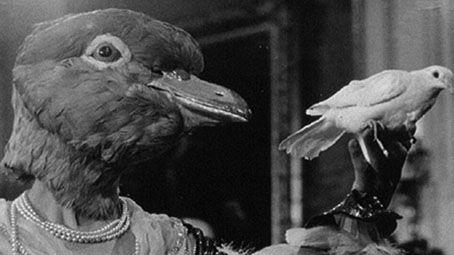
Judex.
It was just over a year ago that I asked “how long do we have to wait for a Judex DVD?” and once again the DVD gods seem to have been listening. Eureka Video’s excellent Masters of Cinema series has paired Franju’s 1963 film with his other Feuillade-inspired work, Nuits rouges.
The magical, rarely seen Judex – directed by the great Georges Franju (Eyes Without a Face) – was largely unappreciated at the time of its release in 1963. This lyrical and dreamlike picture, a putative “remake” of Louis Feuillade’s own 1916 Judex, is as evocative of the silent master’s own works as it is the later films of Jean Cocteau and Salvador Dalí. A French reviewer wrote in 1963: “The whole of Judex reminds us that film is a privileged medium for the expression of poetic magic”. Starring the magician Channing Pollock, the divine Edith Scob, and the mesmerising Francine Bergé, Judex concerns a wicked banker, his helpless daughter, and a mysterious avenger. It plays like a fairy tale – one in which Franju creates a dazzling clash between good and evil, eschewing interest in the psychological aspects of his characters for unexplained twists and turns in the action. The beautifully controlled imagery, superbly rendered by Marcel Fradetal’s black-against-white photography, animates a natural world and the spirits of animals all at war with a host of diabolical forces. Franju’s Judex and Nuits rouges both paid overt homage to the surreal, silent serial-works of Feuillade. Scripted in collaboration with Feuillade’s grandson – Jacques Champreux – these films evince the same poetic magic that made the art of that earlier master a cause célèbre not only for the Surrealist movement, but also for the world-renowned Cinémathèque Française. It was the Cinémathèque (co-founded by the legendary Henri Langlois with Franju) that helped resurrect the reputation of Feuillade decades after he’d slipped out of the public consciousness.
Nuits rouges [Red Nights] – released in the UK as Shadowman – was the second Franju-Champreux meditation upon the films of Feuillade. It aggressively escalates a pulp atmosphere steeped in shocking turns of events to an even more vertiginous level. Here, the object of pursuit is the fabled treasure of the mythical order of the Knights Templar – which the filmmakers use as the jump-off point for staging a series of fantastic set-pieces. As the Fantômas-esque arch-criminal (known only as “The Man Without a Face”, played by Jacques Champreux himself) violently pursues the treasure, the action intensifies amongst a cadre of post-’68 bohemians, the Paris police bureau, and a cult of cowled conspirators. The Masters of Cinema Series is proud to present Georges Franju’s two most mindbending films on DVD in the UK for the first time. —Special Features— Gorgeous new transfers in their original aspect ratios—New and improved English subtitle translations—Video interviews, for both films, by Franju-collaborator Jacques Champreux—40-page booklet containing newly translated interviews with Georges Franju; newly translated writing by Jacques Rivette, and more!
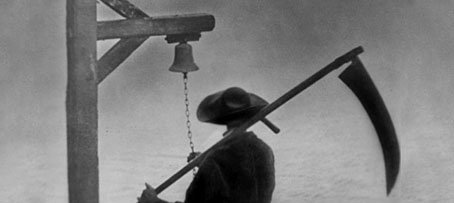
Vampyr.
Eureka’s site seems to be lacking a page for Judex (unless I missed it) but they do have a page for Carl Dreyer’s atmospheric, oneiric and weird-in-all-senses-of-the-word Vampyr (1932), which is receiving a decent UK release at last. This was one of the films I reviewed in 2006 for the André Deutsch book of horror cinema and my own DVD is a very shoddy import copy which I’ll be happy to replace.
The first sound-film by one of the greatest of all filmmakers, Vampyr offers a sensual immediacy that few, if any, works of cinema can claim to match. Legendary director Carl Theodor Dreyer leads the viewer, as though guided in a trance, through a realm akin to a waking-dream, a zone positioned somewhere between reality and the supernatural.
Traveller Allan Gray (arrestingly depicted by Julian West, aka the secretive real-life Baron Nicolas de Gunzburg) arrives at a countryside inn seemingly beckoned by haunted forces. His growing acquaintance with the family who reside there soon opens up a network of uncanny associations between the dead and the living, of ghostly lore and demonology, which pull Gray ever deeper into an unsettling, and upsetting, mystery. At its core: troubled Gisèle, chaste daughter and sexual incarnation, portrayed by the great, cursed Sybille Schmitz (Diary of a Lost Girl, and inspiration for Fassbinder’s Veronika Voss.) Before the candles of Vampyr exhaust themselves, Allan Gray and the viewer alike come eye-to-eye with Fate — in the face of dear dying Sybille, in the blasphemed bodies of horrific bat-men, in the charged and mortal act of asphyxiation — eye-to-eye, then, with Death — the supreme vampire.
Deemed by Alfred Hitchcock ‘the only film worth watching… twice’, Vampyr’s influence has become, by now, incalculable. Long out of circulation in an acceptable transfer, The Masters of Cinema Series is proud to present Dreyer’s truly terrifying film in its restored form for the first time in the UK.
Previously on { feuilleton }
• Judex, from Feuillade to Franju
• Fantômas
• Hail, horrors! hail, infernal world!
• David Rudkin on Carl Dreyer’s Vampyr
Maldoror illustrated
Les Chants de Maldoror by Corominas (2007).
There seems to be no escaping from HP Lovecraft just now, the illustration above having been created for a PDF publication entitled CTHULHU, Cómics y relatos de ficción oscura, produced by these people. The Cthulhu-zine seems to be unavailable but you can see more of these splendid illustrations, based on Lautréamont’s Les Chants de Maldoror (1869), at Dorian Gray BD. The artist, Corominas, has an additional blog showcasing more commercial work.
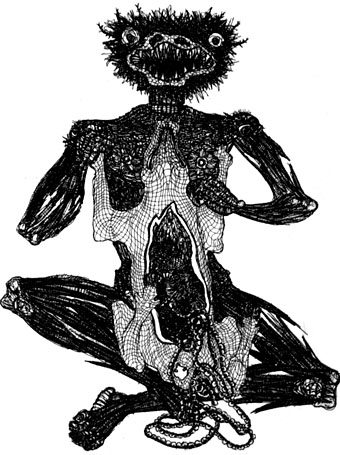
Les Chants de Maldoror by Jacques Houplain (1947).
Lautréamont’s delirious masterpiece isn’t exactly the easiest book to illustrate but the Corominas drawings certainly capture some of its ferocious energy. The Surrealists were big Maldoror enthusiasts, of course, and did much to establish Lautréamont’s current reputation. Salvador Dalí produced a series of engravings for a Skira edition in 1934 although his drawings look less like illustrations of the text than a rifling of the artist’s usual preoccupations. The picture above by Jacques Houplain is one of a series of twenty-seven engravings produced for a French edition in the 1940s. More recently, Jean Benoît created (among other things) a Maldororian dog and there’s even been an attempt at a comic-strip adaptation from Hernandez Palacios. On the whole I prefer the Corominas pictures but then I’m biased towards that style of drawing which owes something to all the comic artists and illustrators influenced by Franklin Booth.
Elsewhere on { feuilleton }
• The illustrators archive
• The etching and engraving archive
Previously on { feuilleton }
• Franklin Booth’s Flying Islands
• Carlos Schwabe’s Fleurs du Mal
• The art of Jean Benoît

